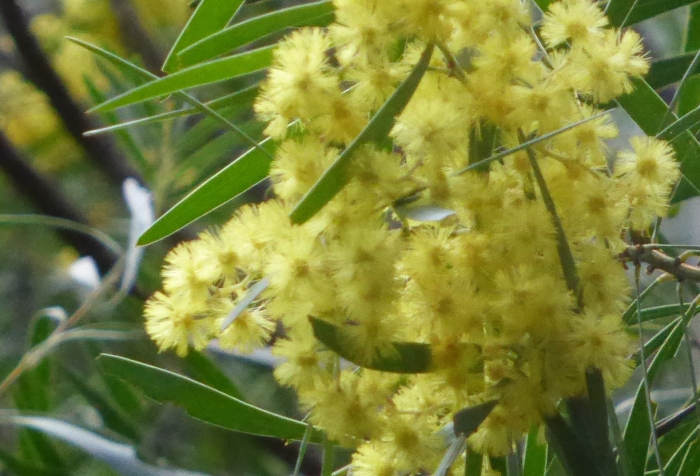Snowy River Wattle
(Acacia boormanii)
Snowy River Wattle (Acacia boormanii)
/
/

Jeanie Clark
CC BY 3.0
Image By:
Jeanie Clark
Recorded By:
Copyright:
CC BY 3.0
Copyright Notice:
Photo by: Jeanie Clark | License Type: CC BY 3.0 | License URL: http://creativecommons.org/licenses/by/4.0/ | Occurence ID: https://www.gbif.org/occurrence/1935324870 | Publisher: Atlas of Living Australia |
























Estimated Native Range
Summary
Acacia boormanii, commonly known as Snowy River Wattle, is an evergreen shrub native to the slopes and plains of Eastern Australia, particularly found in open woodlands and grasslands. It can grow to a height of 4.50 m (15 feet) and a diameter of 1.80 to 3.60 m (6 – 12 feet), featuring a rounded habit with silvery branches and small, gray-green phyllodes (modified leaves) that are about 8 cm long. The Snowy River Wattle is notable for its lemon-yellow, globular flower heads that are profusely borne in panicles, creating a showy display that lasts four to six weeks, typically in late winter to early spring.
The plant is valued for its ornamental qualities, including its striking flower display and silvery foliage. It is used in a variety of cultivation settings such as urban plantings, border plantings, and as a screen or hedge. Acacia boormanii is frost-hardy and tolerates a range of soil conditions, including compacted clay and saline soils, making it a versatile choice for gardeners. It prefers full sun to part shade and requires low to medium amounts of water, with well-drained soils being ideal. While it is generally low-maintenance, it can be susceptible to root rot in poorly drained soils and may be affected by pests such as borers or sap-sucking insects.CC BY-SA 4.0
The plant is valued for its ornamental qualities, including its striking flower display and silvery foliage. It is used in a variety of cultivation settings such as urban plantings, border plantings, and as a screen or hedge. Acacia boormanii is frost-hardy and tolerates a range of soil conditions, including compacted clay and saline soils, making it a versatile choice for gardeners. It prefers full sun to part shade and requires low to medium amounts of water, with well-drained soils being ideal. While it is generally low-maintenance, it can be susceptible to root rot in poorly drained soils and may be affected by pests such as borers or sap-sucking insects.CC BY-SA 4.0
Plant Description
- Plant Type: Tree
- Height: 10-15 feet
- Width: 5-15 feet
- Growth Rate: Rapid
- Flower Color: Yellow
- Flowering Season: Spring
- Leaf Retention: Evergreen
Growth Requirements
- Sun: Full Sun, Part Shade
- Water: Medium
- Drainage: Fast, Medium
Common Uses
Bee Garden, Bird Garden, Drought Tolerant, Hedges, Hummingbird Garden, Low Maintenance, Salt Tolerant, Showy Flowers, Street Planting
Natural Habitat
Native to the slopes and plains of Eastern Australia, particularly found in open woodlands and grasslands
Other Names
Common Names:
Scientific Names: , Acacia boormanii, Racosperma boormanii,
GBIF Accepted Name: Acacia boormanii Maiden